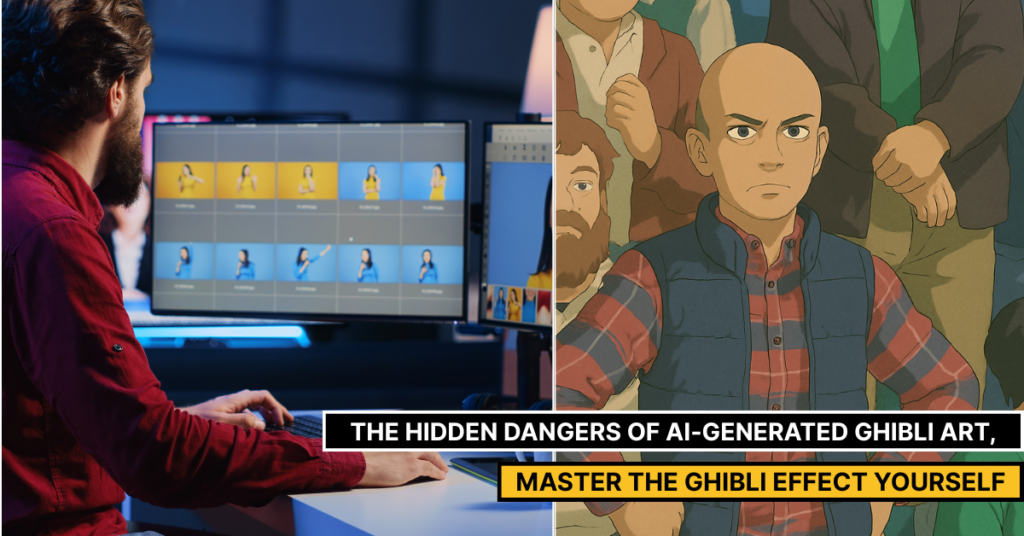
The Hidden Dangers of AI-Generated Ghibli Effect Video Editing, Master the Ghibli Effect Yourself
The recent trend of using AI to generate the Ghibli Effect Video Editing may seem simple and easy, but it comes with alarming risks. By giving your photos, videos & creative work to AI tools, you might unknowingly submit your originality, expose personal information, and even allow AI companies to claim rights over your content. AI-generated art can take away human touch leaving behind soulless and unauthentic content.
Instead of risking your privacy why not learn the art of crafting the Ghibli effect yourself?
At Vastvik Films, a leading production house in Mumbai & Chandigarh, we explore step-by-step editing techniques to infuse the Ghibli effect into modern digital filmmaking, while ensuring the authenticity of your work.
What is the Ghibli Effect and Why Does It Matter?
The Ghibli effect is a combination of nostalgia, beautiful, painterly backgrounds, and artistic animations. It captures a dreamlike essence that transfers viewers into dreamy imaginations. It uses techniques like grading, soft lighting, rich color palettes smooth camera movements to create a perfect cinematic look. Instead of using AI filters, real filmmakers and editors carefully create this style while keeping the human touch alive in their work.
Step-by-Step Editing Guide to the Ghibli Look
1.Cinematic Color Grading – Creating the Ghibli Palette
To create Ghibli films’ warm, earthly tones and pastels, do these steps in your editing software:
- Use Adobe Premiere Pro or Davinci Resolve for correct color grading.
- Apply LUTs(Look-Up Tables) to give a hand-painted, dreamy feel.
- Boost blues & greens to make outdoor scenes look more beautiful.
- Adjust contrast and saturation for a nostalgic and soft look.
2. Soft, Dreamlike Lighting – Enhancing in Post-Production
If your video doesn’t have the soft, magical glow of Ghibli-inspired videos, here’s how to fix it in the post:
- Use diffusion effects in Premiere Pro or After Effects to soften harsh lights
- Add subtle vignettes to focus attention and create a cinematic look.
- Layer light leaks and broken effects to mimic natural, whimsical lighting.
3. Hand-Painted Backgrounds – Transforming Images into Ghibli-Style Art
A big part of Ghibli Effect Video Editing is unique style is its hand-painted backgrounds. Here is how you can achieve the same effect:
- Extract backgrounds from your footage and add a painting-style filter in Photoshop.
- Use Topaz Studio to turn your photos into watercolor paintings.
- Blend AI-generated art with real footage for a blend of animation and live-action.
4. Smooth Camera Movements – Creating Dreamy Flow
Gibhi films have slow, gentle camera movement, you can replicate this in editing:
- Using warp stabilizer in Premiere Pro to remove shakiness and smooth camera pans.
- Apply slow-motion effects to make movements feel soft and floating.
- Use parallax effects in After Effects to add depth to still images.
5. Expressive Movements-Adjusting Frame Rates for an Animated Feel
To make character movements more like animation, try these steps:
- Lower the frame rate to 12-15 fps in After Effects to create hand-drawn animation
- Use Twixtor to create smoother frame transitions.
- Slightly exaggerate key movements using keyframe adjustments.
6. Sound & Music for Emotional Depth – Adding the Ghibli Feel
Sound plays an important role in enhancing the Ghibli effect. Here’s how to add depth to your video:
- Use a soft piano to match the emotional tone.
- Add nature sounds like rustling leaves and gentle winds.
- Apply reverb and ambient effects to make the scene feel immersive.
Final Thoughts: Bring the Ghibli Magic to Your Videos
At Vastvik Films, a leading production house in Mumbai, we believe great storytelling is an art. By using these editing techniques in filmmaking and marketing, you can create —just like a Ghibli film.
Whether you’re working on a film project, a commercial, or a music video, these post-production techniques will add a unique, timeless charm to your content.

